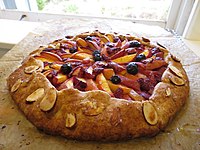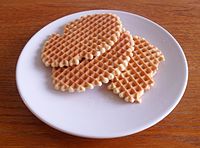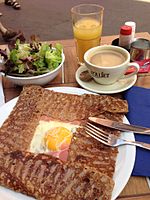 A galette des Rois A galette des Rois | |
| Type | Cake or waffle |
|---|---|
| Place of origin | France |
| Region or state | Normandy, Brittany, French Guiana |
| Main ingredients | Flour |
| Variations | Breton galette (galette bretonne), king cake, Creole galette |
Galette (from the Norman word gale, meaning "flat cake") is a term used in French cuisine to designate various types of flat round or freeform crusty cakes, or, in the case of a Breton galette (French: Galette bretonne [galɛt bʁətɔn]; Breton: Krampouezhenn gwinizh du), a pancake made with buckwheat flour usually with a savoury filling. Of the cake type of galette, one notable variety is the galette des Rois (King cake) eaten on the day of Epiphany. In French Canada the term galette is usually applied to pastries best described as large cookies.
Fruit galette

A common form of galette resembles a type of single crust, free-form pie with a fruit filling and the crust folded partway over the top of the filling. The website joyofbaking.com defines the term galette as "a French term signifying a flat round cake that can be either sweet or savory and while puff pastry as a base, they can also be made from risen doughs like brioche, or with a sweet pastry crust."

The fruits used in these types of galettes are typically seasonal and can include one or more of apples; berries such as strawberries or blueberries; or stone fruits such as peaches, plums, nectarines, or cherries. Various spices, zests, or peppers can be added in the preparation process if desired. The pastry base is often homemade but can also be commercially purchased; leftover supplies such as graham crackers can be employed as well. Fruit galettes can be served warm and/or with ice cream.
Bon Appétit magazine has written of such galettes, "They're casually impressive and photogenic, but in that 'Oh, I just threw this together' way. They're rustic and inviting; come as you are. ... Their imperfections are what set them apart—in fact, the less you do, the better they look."
Savory galettes
| This section needs additional citations for verification. Please help improve this article by adding citations to reliable sources in this section. Unsourced material may be challenged and removed. Find sources: "Galette" – news · newspapers · books · scholar · JSTOR (July 2024) (Learn how and when to remove this message) |
Savory galettes are a versatile and rustic form of tart, distinguished by their free-form crust that encases a variety of savory fillings. Unlike traditional tarts or pies, galettes are made by folding the edges of a single sheet of dough over the filling, leaving the center exposed. This method results in a visually appealing, golden-brown crust that adds a delightful crunch to each bite.
Common fillings for savory galettes include a mix of vegetables, cheeses, meats, and herbs. They can be eaten as a main course or as a side dish. Popular combinations include spinach and feta, mushrooms and Gruyère, and ratatouille-style vegetables.
Heirloom tomato galettes
Heirloom tomato galettes are a variant of the savory galette, showcasing the vibrant flavors and colors of heirloom tomatoes. Heirloom tomatoes are known for their unique shapes, sizes, and rich taste. Typically, the heirloom tomatoes are sliced and arranged over a bed of cheese, such as ricotta, mozzarella, or goat cheese, often accompanied by herbs like basil or thyme. The edges of the dough are then folded over the filling, leaving the colorful tomatoes visible in the center.
Heirloom tomato galettes are often enjoyed at picnics, brunches, or as a light dinner.
Mushroom and gruyère galettes
Mushroom and Gruyère galettes are another popular type of savory galette. Typically, a variety of mushrooms such as cremini, shiitake, and oyster mushrooms are sautéed with garlic and thyme until tender and fragrant. The mushrooms are then layered over a bed of Gruyère cheese. The dough is folded over the edges of the filling, creating a rustic, golden-brown crust.
Ratatouille galettes
Ratatouille galettes take inspiration from the classic French dish, ratatouille, which features a mix of summer vegetables such as eggplant, zucchini, bell peppers, and tomatoes. These vegetables are thinly sliced and layered over a bed of ricotta or goat cheese, often seasoned with garlic, herbs de Provence, and olive oil. The vegetables are arranged in a visually appealing pattern, and the edges of the dough are folded over to create a rustic border.
Breton galette
Main article: Kaletez| This section needs additional citations for verification. Please help improve this article by adding citations to reliable sources in this section. Unsourced material may be challenged and removed. Find sources: "Galette" – news · newspapers · books · scholar · JSTOR (July 2024) (Learn how and when to remove this message) |
Galette, which is more properly called Breton galette, is also the name given in most French crêperies to savoury buckwheat flour pancakes, while those made from wheat flour, much smaller in size and mostly served with a sweet filling, are branded crêpes. This type of galette is a large, thin pancake mostly associated with the region of Brittany, where it replaced at times bread as basic food, but it is eaten countrywide. Buckwheat was introduced as a crop suitable to impoverished soils and buckwheat pancakes were known in other regions where this crop was cultivated, such as Limousin or Auvergne.
It is frequently garnished with egg, meat, fish, cheese, cut vegetables, apple slices, berries, or similar ingredients. One of the most popular varieties is a galette covered with grated Emmental cheese, a slice of ham, and an egg cooked on the galette. In France this is known as a galette complète (a complete galette). Another variety is a hot sausage wrapped in a galette (called galette saucisse, a tradition of Rennes, Brittany) and eaten like a hot dog.
-
 Galettes campinoises are a type of galette or waffle popular in Belgium.
Galettes campinoises are a type of galette or waffle popular in Belgium.
-
 A galette complète served in Annecy, France
A galette complète served in Annecy, France
-
A galette and cider in Villedieu-les-Poêles, Normandy, France
Creole galette
The Guianan galette (more commonly known as the Creole galette) is a traditional pastry of French Guianan cuisine. This is a Creole variant of the galette des rois which is eaten as a dessert during Epiphany.
It can be garnished with cream, coconut, guava, etc. It is consumed throughout the Carnival period (from the Epiphany until Lent, beginning Ash Wednesday) and preferably accompanied by champagne.
See also
- Bing (Chinese flatbread) – Chinese flatbreadPages displaying short descriptions of redirect targets
- Crepe maker – cooking device used to make crepes, galettes, pancakes, blinis or tortillasPages displaying wikidata descriptions as a fallback
- Kouign amann – Breton pastryPages displaying short descriptions of redirect targets
- List of pancakes
- List of sausage dishes
References
- Lebovitz, David (September 2000). "Free-form Rustic Tarts: Whether Sweet or Savory, a Galette is Less Fussy than a Traditional Tart and Offers More Crisp Crust". Fine Cooking. No. 40. Taunton Press. ISSN 1072-5121. Archived from the original on 2022-08-29. Retrieved 2022-08-29.
- See several such recipes in Deborah Madison, Vegetarian Cooking for Everyone.
- ^ "Apple Galette Recipe & Video". JoyofBaking.com. Retrieved 20 July 2006.
- ^ Music, Carla Lalli (September 2019). "Yes, You Can Galette That". Bon Appétit. pp. 86–91.
- ^ Davis, Dawn (August 2021). "Editor's Letter". Bon Appétit. pp. 8, 48.
- Anne Willan (2007), The Country Cooking of France, San Francisco, Calif.: Chronicle Books, p. 236, ISBN 978-0-8118-4646-2,
GALETTES BRETONNES AU SARRASIN. BRETON BUCKWHEAT GALETTES. The filling for a paper-thin Breton galette is always simple. The most popular, called a complet, includes ham and egg and often a spoonful of fresh cheese. You can ask for the egg to be brouillé, briskly scrambled on the hot galette, or miroir, left untouched to bake on top. When the galette is pleated, the golden egg yolk peeps out of the crisp brown folds.
- Le carnaval des familles